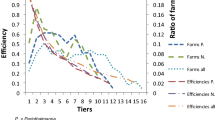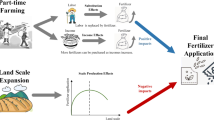Abstract
This study conducted a dual microanalysis of modern agricultural inputs use behaviour in rural areas of Kano State, Nigeria. Probit regression model was estimated to analyse the factors that influence modern inputs adoption. On the other hand, OLS, Poisson and instrumental variable regression models were used to estimate the efficiency of modern inputs adoption and consumption at farm level. The estimated OLS model indicates that additional use of 1 bag of fertiliser, increases the level of productivity by about 5.4%. Similarly, the estimated Poisson model indicates that an additional 1 bag of fertiliser use on a farm increases the productivity per hectare by about 4.5%. Meanwhile, the estimated 2SLS model shows that a 1% increase in the amount of fertiliser use increases the level of output productivity by about 0.34%. Furthermore, the method adopted by farmers on how to use modern agricultural inputs has a significant influence on the level of output production. Modern method of fertiliser application improves the level of output production. Government can use this medium to improve the rate of input use by rural farmers via agricultural schemes that will introduce the farmers to and maintain the modern techniques of farming. Additionally, farmers need to be exposed to skills and training on some off-farm jobs to raise their income to be able to afford the recommended amount of fertiliser. Lastly, the adoption of policies that will encourage the rate of farmers’ contact with extension agents will improve the manner of fertiliser utilisation which in turn increases the level of efficiency.


Similar content being viewed by others
References
Agresti A (2002) Categorical data analysis. Wiley, Hoboken
Akpan SB, Udoh EJ, Nkanta VS (2012) Factors influencing fertilizer use intensity among Small Holder Crop Farmers in Abak Agricultural Zone in Akwa Ibom State, Nigeria. J Biol Agric Healthc 2:54–65
Amadi AC (2010) An assessment of the socio-economic factors influencing fertilizer use among sugarcane farmers in Mumias. Dissertation, University of Nairobi
Arslan A, McCarthy N, Lipper L, Asfaw S, Cattaneo A (2013) Adoption and intensity of adoption of conservation farming practices in Zambia. Agric Ecosyst Environ 187:72–86
Assa M, Mehire A, Ngoma K, Magombo E, Gondwe P (2014) Determinants of smallholder farmers’ demand for purchased inputs in Lilongwe District, Malawi: Evidence from Mitundu extension planning area. Middle East J Sci Res 19:1313–1318
Bartlett JE, Kotrlik JW, Higgins C (2001) Organizational research: determining appropriate sample size in survey research. Inf Technol Learn Perform J 19:43–50
Chembezi DM (1990) Estimating fertiliser demand and output supply for Malawi’s smallholder agriculture. Agric Syst 33:293–314
Danlami AH (2014) Determinants of demand for fertiliser: a conceptual review. IOSR J Econ Finance 4:45–48
Danlami AH, Islam R, Applanaidu SD, Tsauni AM (2016) An empirical analysis of fertiliser use intensity in rural Sub-Saharan Africa Evidence from Tofa local government area, Kano State, Nigeria. Int J Soc Econ 43:1400–1419
Dillman DA (2011) Mail and internet surveys: the tailored design method-2007 update with new internet, visual, and mixed-mode guide. Wiley, Hoboken
Druilhe Z, Barreiro-Hurlé J (2012) Fertiliser subsidies in sub-Saharan Africa (No. 12-04). ESA working paper
Eakins J (2013) An analysis of the determinants of household energy expenditures: empirical evidence from the Irish household budget survey. Dissertation, University of Surrey
Filippini M, Pachauri S (2004) Elasticities of electricity demand in urban Indian households. Energy Policy 32:429–436
Greene WH (2002) Econometric analysis. Prince Hall Ltd., Newark
Idrisa YL, Gwary MM, Shehu H (2008) Analysis of food security status among farming households in Jere Local Government of Borno State, Nigeria. J Trop Agric Food Environ Ext 7:199–205
Idris AR, Ahmad N (2013) Demand for fertilizer in least developed countries (LDCs). Can Soc Sci 9:27–34
Kefyalew E (2010) Fertilizer consumption and agricultural productivity in Ethiopia. Working Papers 003, Ethiopian Development Research Institute, Addis Ababa, Ethiopia
Kormawa P, Munyemana A, Soule B (2003) Fertiliser market reforms and factors influencing fertiliser use by small-scale farmers in Bénin. Agric Ecosyst Environ 100:129–136
Ma L, Feng S, Reidsma P, Qu F, Heerink N (2014) Identifying entry points to improve fertiliser use efficiency in Taihu Basin, China. Land Use Policy 37:52–59
Mariano MJ, Villano R, Fleming E (2012) Factors influencing farmers’ adoption of modern rice technologies and good management practices in the Philippines. Agric Syst 110:41–53
Marenya P, Nkonya E, Xiong W, Deustua J, Kato E (2012) Which policy would work better for improved soil fertility management in sub-Saharan Africa, fertiliser subsidies or carbon credits? Agric Syst 110:162–172
Mwangi WM (1996) Low use of fertilisers and low productivity in sub-Saharan Africa. Nutr Cycl Agroecosyst 47:135–147
Naseem A, Kelly VA (1999) Macro trends and determinates of fertilizer use in Sub-Saharan Africa (No. 54671). Michigan State University
Nkamleu GB, Adesina AA (2000) Determinants of chemical input use in peri-urban lowland systems: bivariate probit analysis in Cameroon. Agric Syst 63:111–121
Oad FC, Buriro UA, Agha SK (2004) Effect of organic and inorganic fertilizer application on maize fodder production. Asian J Plant Sci 3:375–377
Olayide OE, Alene AD, Ikpi A (2009) Determinants of fertiliser use in Northern Nigeria. Pak J Soc Sci 6:91–98
Paudel P, Kumar AS, Matsuoka A (2009) Socio-economic factors influencing adoption of fertiliser for maize production in Nepal: a case study of Chitwan District. A paper presented at the 83rd annual conference of the Agricultural Economics Society, Dublin
Rani A (2014) Consumption of chemical fertilisers in Haryana: an empirical study. ZENITH Int J Bus Econ Manag Res 4:105–112
Roscoe JT (1975) Fundamental research statistics for the behavioural sciences. Holt, Rinehart and Winston, New York
Saweda LO, Tasie L (2014) Fertiliser subsidies and private market participation: the case of Kano State, Nigeria. Agric Econ 45:663–678
Schreinemachers P, Berger T, Aune JB (2007) Simulating soil fertility and poverty dynamics in Uganda: a bio-economic multi-agent systems approach. Ecol Econ 64:387–401
Sekaran U (2003) Research methods for business: a skill-building approach. Wiley, Hoboken
Sharma VP, Thaker H (2011) Demand for fertiliser in India: determinants and outlook for 2020. W.P. No. 2011-04-01. Indian Institute of Management
Sheahan M, Black R, Jayne TS (2013) Are Kenyan farmers under-utilizing fertiliser? Implications for input intensification strategies and research. Food Policy 41:39–52
Singh H, Solanki RS (2014) Factors influencing the use of fertilisers in agriculture of Madhya Pradesh in India. Int J Sci Res Math Stat Sci 1:18–40
Takeshima H, Nkonya E (2014) Government fertiliser subsidy and commercial sector fertiliser demand: evidence from the Federal Market Stabilization Program (FMSP) in Nigeria. Food Policy 47:1–12
Varma A, Bakshi M, Lou B, Hartmann A, Oelmueller R (2012) Piriformospora indica: a novel plant growth-promoting Mycorrhizal fungus. Agric Res 1:117–131
Wakeyo MB, Gardebroek C (2013) Does water harvesting induce fertiliser use among smallholders? Evidence from Ethiopia. Agric Syst 114:54–63
Wooldridge JM (2012) Introductory econometrics. South-Western Publishers, Mason
Acknowledgements
The authors are grateful to the editor in chief (Agricultural Research Journal) Dr. Anupam Varma and the anonymous reviewers for improving the quality of the paper.
Author information
Authors and Affiliations
Corresponding author
Rights and permissions
About this article
Cite this article
Danlami, A.H., Applanaidu, SD. & Islam, R. A Microlevel Analysis of the Adoption and Efficiency of Modern Farm Inputs Use in Rural Areas of Kano State, Nigeria. Agric Res 8, 392–402 (2019). https://doi.org/10.1007/s40003-018-0373-z
Received:
Accepted:
Published:
Issue Date:
DOI: https://doi.org/10.1007/s40003-018-0373-z




